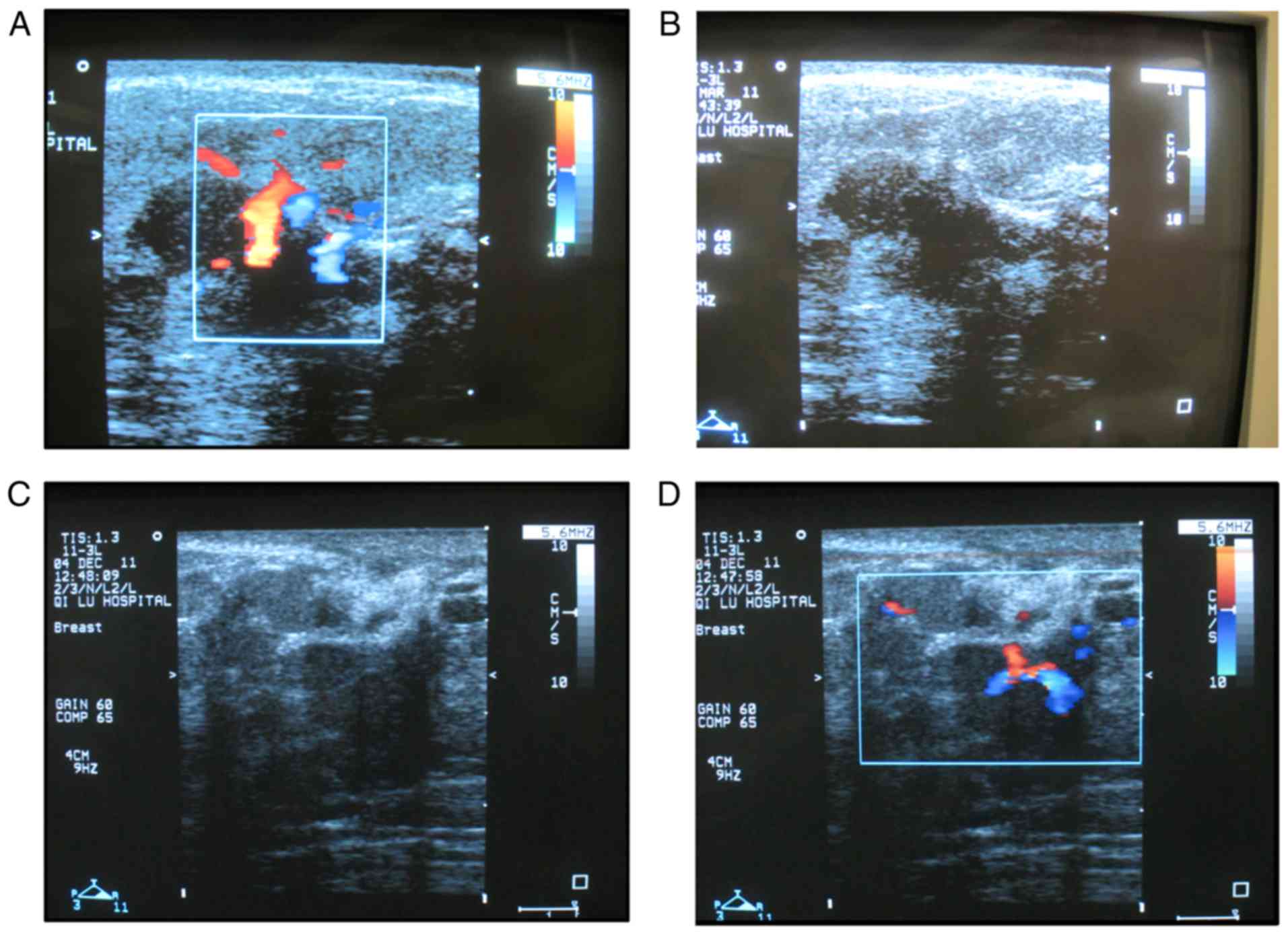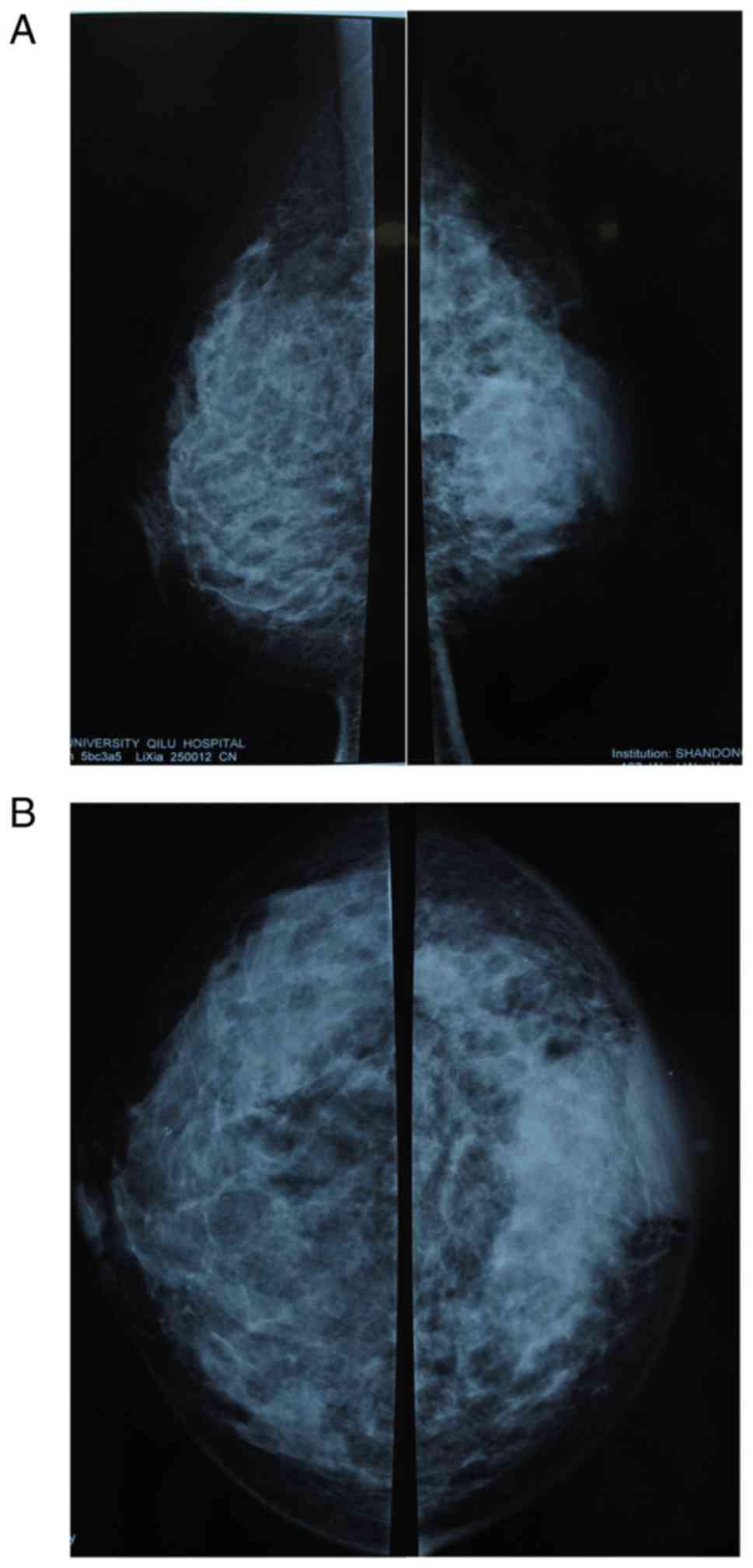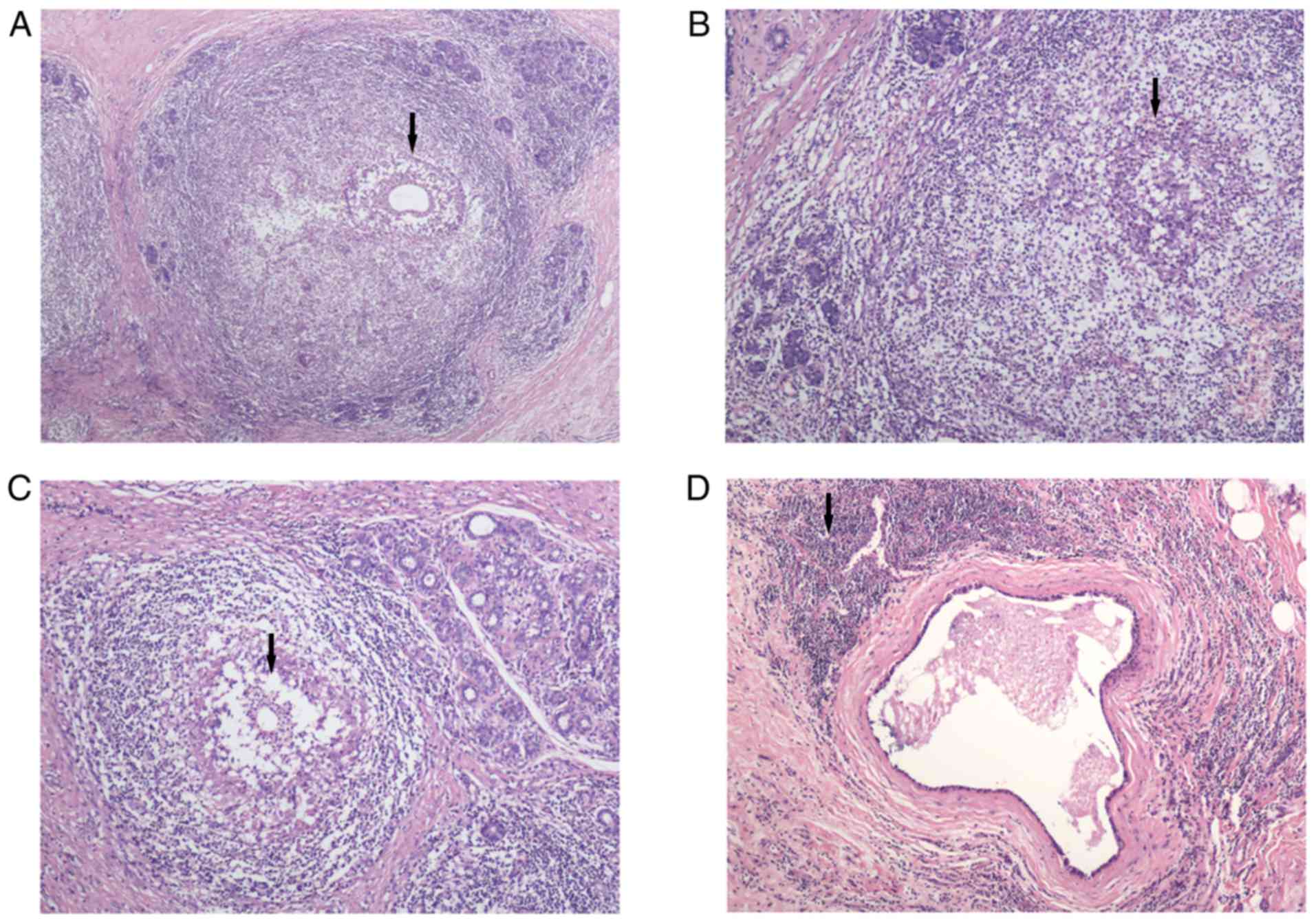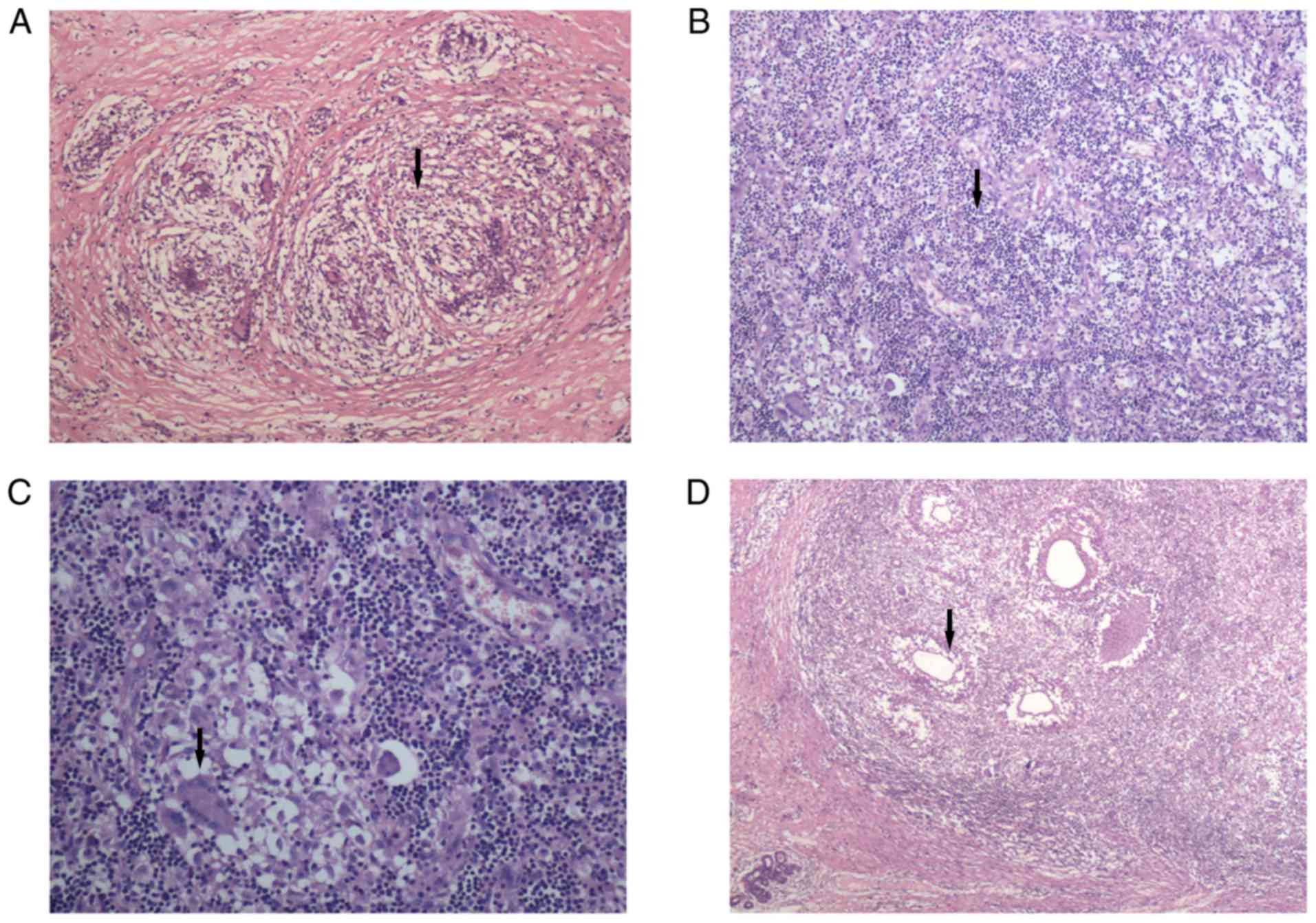|
1
|
Kessler E and Wolloch Y: Granulomatous
mastitis: A lesion clinically simulating carcinoma. Am J Clin
Pathol. 58:642–646. 1972. View Article : Google Scholar : PubMed/NCBI
|
|
2
|
Milward TM and Gough MH: Granulomatous
lesions in the breast presenting as carcinoma. Surg Gynecol Obstet.
130:478–482. 1970.PubMed/NCBI
|
|
3
|
Miller F, Seidman I and Smith CA:
Granulomatous mastitis. N Y State J Med. 71:2194–2195.
1971.PubMed/NCBI
|
|
4
|
Davies JD and Burton PA: Postpartum
lobular granulomatous mastitis. J Clin Pathol. 36:3631983.
View Article : Google Scholar : PubMed/NCBI
|
|
5
|
Going JJ, Anderson TJ, Wilkinson S and
Chetty U: Granulomatous lobular mastitis. J Clin Pathol.
40:535–540. 1987. View Article : Google Scholar : PubMed/NCBI
|
|
6
|
Pereira FA, Mudgil AV, Macias ES and
Karsif K: Idiopathic granulomatous lobular mastitis. Int J
Dermatol. 51:142–151. 2012. View Article : Google Scholar : PubMed/NCBI
|
|
7
|
Tournemaine N, Nomballais F, Weber J,
Digabel-Chabay C, Bertrand AF and Cousin C: Granulomatous lesions
of the breast. Their role in inflammatory breast pathology and
their relations to lobular granulomatous mastitis. J Gynecol Obstet
Biol Reprod (Paris). 16:75–83. 1987.(In French). PubMed/NCBI
|
|
8
|
Cserni G and Szajki K: Granulomatous
lobular mastitis following drug-induced galactorrhea and blunt
trauma. Breast J. 5:398–403. 1999. View Article : Google Scholar : PubMed/NCBI
|
|
9
|
Hmissa S, Sahraoui W, Missaoui N, Stita W,
Mokni M, Yacoubi MT, Khairi H and Korbi S: Lobular idiopathic
granulomatos mastitis. About 10 cases. Tunis Med. 84:353–357.
2006.(In French). PubMed/NCBI
|
|
10
|
Al Nazer MA: Idiopathic granulomatus
lobular mastitis. A forgotten clinical diagnosis. Saudi Med J.
24:1377–1380. 2003.PubMed/NCBI
|
|
11
|
Gurleyik G, Aktekin A, Aker F, Karagulle H
and Saglamc A: Medical and surgical treatment of idiopathic
granulomatous lobular mastitis: A benign inflammatory disease
mimicking invasive carcinoma. J Breast Cancer. 15:119–123. 2012.
View Article : Google Scholar : PubMed/NCBI
|
|
12
|
Galea MH, Robertson JF, Ellis IO, Elston
CW and Blamey RW: Granulomatous lobular mastitis. Aust N Z J Surg.
59:547–550. 1989. View Article : Google Scholar : PubMed/NCBI
|
|
13
|
Kfoury H and Al Bhlal L: Granulomatous
lobular mastitis: A clinicopathological study of 112 cases. Ann
Saudi Med. 17:43–46. 1997. View Article : Google Scholar : PubMed/NCBI
|
|
14
|
Mote DG, Gungi RP, Satyanarayana V and
Premsunder T: Granulomatous mastitis-a diagnostic dilemma. Indian J
Surg. 70:241–243. 2008. View Article : Google Scholar : PubMed/NCBI
|
|
15
|
Bani-Hani KE, Yaghan RJ, Matalka II and
Shatnawi NJ: Idiopathic granulomatous mastitis: Time to avoid
unnecessary mastectomies. Breast J. 10:318–322. 2004. View Article : Google Scholar : PubMed/NCBI
|
|
16
|
Wilson JP, Massoll N, Marshall J, Foss RM,
Copeland EM and Grobmyer SR: Idiopathic granulomatous mastitis: In
search of a therapeutic paradigm. Am Surg. 73:798–802.
2007.PubMed/NCBI
|
|
17
|
Baslaim MM, Khayat HA and Al-Amoudi SA:
Idiopathic granulomatous mastitis: A heterogeneous disease with
variable clinical presentation. World J Surg. 31:1677–1681. 2007.
View Article : Google Scholar : PubMed/NCBI
|
|
18
|
Al-Khaffaf B, Knox F and Bundred NJ:
Idiopathic granulomatous mastitis: A 25-year experience. J Am Coll
Surg. 206:269–273. 2008. View Article : Google Scholar : PubMed/NCBI
|
|
19
|
Sheybani F, Sarvghad M, Naderi HR and
Gharib M: Treatment for and clinical characteristics of
granulomatous mastitis. Obstet Gynecol. 125:801–807. 2015.
View Article : Google Scholar : PubMed/NCBI
|
|
20
|
Tuli R, O'Hara BJ, Hines J and Rosenberg
AL: Idiopathic granulomatous mastitis masquerading as carcinoma of
the breast: A case report and review of the literature. Int Semin
Surg Oncol. 4:212007. View Article : Google Scholar : PubMed/NCBI
|
|
21
|
Rahal RM, de Freitas-Júnior R and
Paulinelli RR: Risk factors for duct ectasia. Breast J. 11:262–265.
2005. View Article : Google Scholar : PubMed/NCBI
|
|
22
|
Marriott DA, Russell J, Grebosky J,
Wallace AM, Joste N and Royce ME: Idiopathic granulomatous lobular
mastitis masquerading as a breast abscess and breast carcinoma. Am
J Clin Oncol. 30:564–565. 2007. View Article : Google Scholar : PubMed/NCBI
|
|
23
|
Centers for Disease and Control and
Prevention (CDC): Idiopathic granulomatous mastitis in Hispanic
women-Indiana, 2006–2008. MMWR Morb Mortal Wkly Rep. 58:1317–1321.
2009.PubMed/NCBI
|
|
24
|
Tse GM, Poon CS, Law BK, Pang LM, Chu WC
and Ma TK: Fine needle aspiration cytology of granulomatous
mastitis. J Clin Pathol. 56:519–521. 2003. View Article : Google Scholar : PubMed/NCBI
|
|
25
|
Gupta RK: Fine needle aspiration cytology
of granulomatous mastitis: A study of 18 cases. Acta Cytol.
54:138–141. 2010. View Article : Google Scholar : PubMed/NCBI
|
|
26
|
DeHertogh DA, Rossof AH, Harris AA and
Economou SG: Prednisone management of granulomatous mastitis. N
Engl J Med. 303:799–800. 1980. View Article : Google Scholar : PubMed/NCBI
|
|
27
|
Schmajuk G and Genovese MC: First report
of idiopathic granulomatous mastitis treated with methotrexate
monotherapy. J Rheumatol. 36:1559–1560. 2009. View Article : Google Scholar : PubMed/NCBI
|
|
28
|
Lai EC, Chan WC, Ma TK, Tang AP, Poon CS
and Leong HT: The role of conservative treatment in idiopathic
granulomatous mastitis. Breast J. 11:454–456. 2005. View Article : Google Scholar : PubMed/NCBI
|
|
29
|
Stary CM, Lee YS and Balfour J: Idiopathic
granulomatous mastitis associated with corynebacterium sp.
Infection. Hawaii Med J. 70:99–101. 2011.PubMed/NCBI
|
|
30
|
Schelfout K, Tjalma WA, Cooremans ID,
Coeman DC, Colpaert CG and Buytaert PM: Observations of an
idiopathic granulomatous mastitis. Eur J Obstet Gynecol Reprod
Biol. 97:260–262. 2001. View Article : Google Scholar : PubMed/NCBI
|
|
31
|
Adler NR, Wolfe R, McArthur GA, Kelly JW,
Haydon A, McLean CA and Mar VJ: Tumour mutation status and melanoma
recurrence following a negative sentinel lymph node biopsy. Br J
Cancer. 118:1289–1295. 2018. View Article : Google Scholar : PubMed/NCBI
|
|
32
|
Ocal K, Dag A, Turkmenoglu O, Kara T,
Seyit H and Konca K: Granulomatous mastitis: Clinical, pathological
features, and management. Breast J. 16:176–182. 2010. View Article : Google Scholar : PubMed/NCBI
|
|
33
|
Akça T, Çolak T, Çağlıkülekçi M, Öcal K
and Aydın S: Intestinal perforation in Wegener's granulomatosis: A
case report. Ulus Travma Acil Cerrahi Derg. 11:348–351.
2005.PubMed/NCBI
|



















